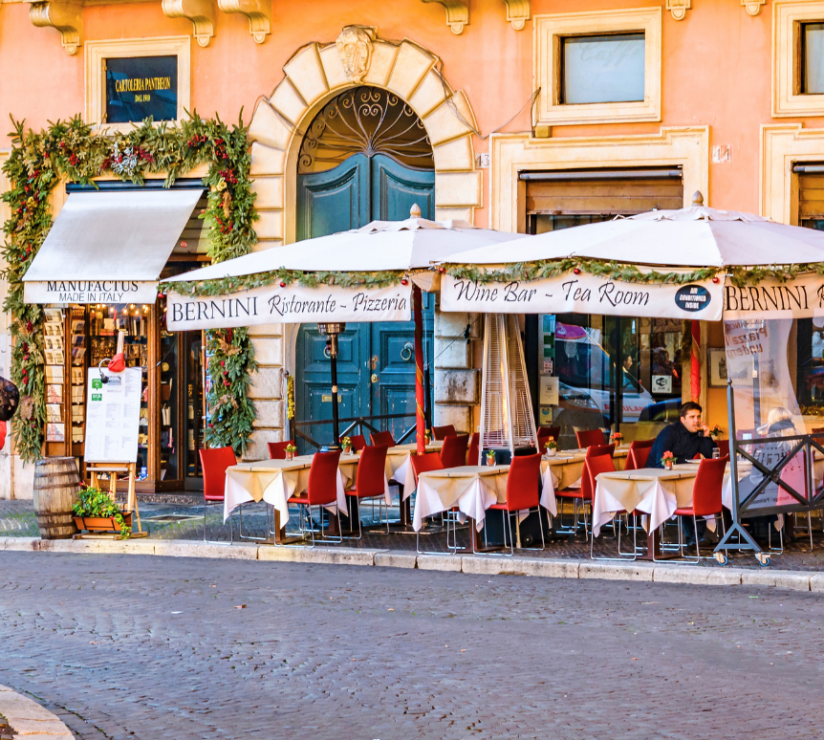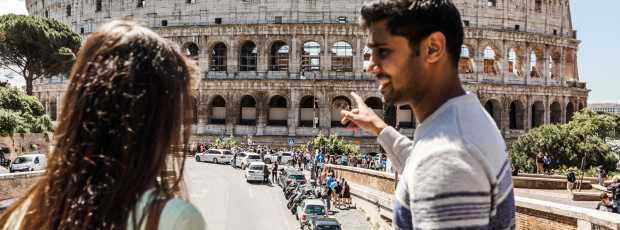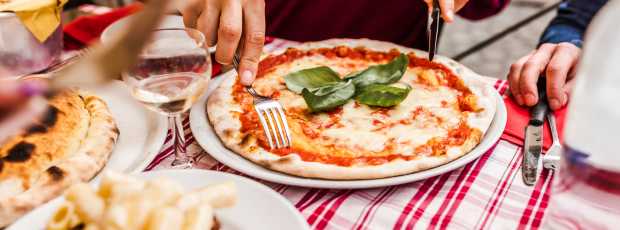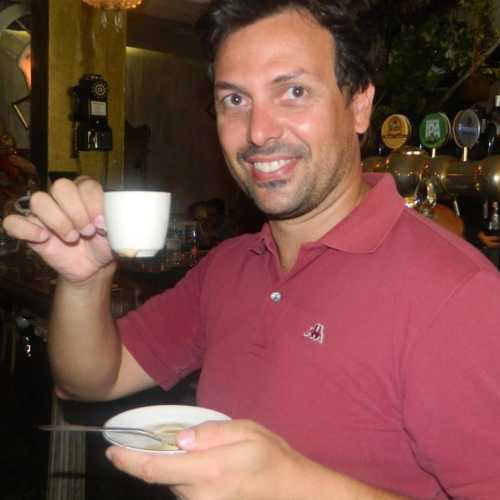Our tour Gide Ugo was amazing show us private tour most amazing places very knowledgeable also he spent extra time with us we will highly recommend him thanks Ugo making our trips memorable !!Dikran, Rome, 2025
See Rome’s hidden side on a private tour
Private tours, designed around you
Table Of Contents
- You Haven’t Really Done Rome Without These Five Rituals
- Must-See Things to Do in Rome
- Overrated Sights in Rome, and Smarter Alternatives
- Hidden Gems That Deliver Authentic Roman Experiences
- Food That Defines Rome: Dishes and Daily Rituals
- Signature Leisure and Culture: Evenings That Feel Roman
- Rome by Interest: Themes That Fit Your Day
- Rome Neighborhoods: Where the City Really Lives
- Practical Tips for Rome: Transport, Tickets, Etiquette
- Frequently Asked Questions: Things to Do in Rome
- Final Notes on Rome: Let the City Lead
Rome lives on two clocks. One is the daily one I grew up with: the barista who knows your order, shutters that rise and fall with lunch, school runs, football fixtures, bus timetables. The other is older and slower: streets that bend around ruins, bells that mark feast days, sunlight crawling across travertine the way it has since emperors walked here. I move between both without thinking. It’s why the extraordinary feels normal.
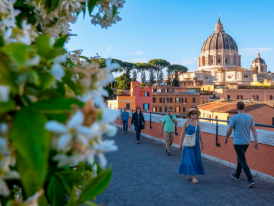
Early morning light on St. Peter's dome from a city terrace
When people ask about things to do in Rome, I tell them to watch how the Italian capital city behaves. At the counter, you drink fast and stand. Just a stone’s throw away, the Colosseum and the Roman Forum pull you back a couple of millennia. This European city stacks ancient temples, Renaissance art, and Baroque fountains without fuss.
The Eternal City never gets old because its layers and rich history still work. Start with the famous places, then follow the street noise into the neighborhoods. If you want a steady hand, use my Rome experiences as a loose plan and make them your own.
You Haven’t Really Done Rome Without These Five Rituals
Before the big names, five small rituals set the pace. They cost almost nothing and teach you how the city moves.
Espresso at the Counter
Order, drink fast, step back outside. By the second visit, the barista knows your rhythm. Sugar if you like, but no cappuccino after 11 AM. Exact change speeds the line, and the saucer stays where it lands. Thirty seconds and Rome is already in your shoes.
Trevi Fountain: The Coin Toss Ritual
Trevi Fountain is Rome’s most famous fountain, and one of the most photographed in the entire world. Face away from the basin, then throw a coin with your right hand over your left shoulder. I go after dinner, around 8 or 9 PM, when the stone cools and the sound of water takes over. The Aqua Virgo still feeds Trevi, which is why it runs clear. If the square uses one-way flow, slip straight into the side lanes for a few quiet turns.
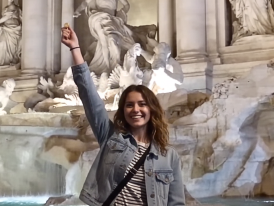
Evening coin toss at the Trevi Fountain in Rome
The Evening Passeggiata
The passeggiata is our pre-dinner stroll. From about 6.30 to 8.30 PM. I come out to walk, greet, and be seen. Not exercise. A reset and a hello to the neighborhood. Pace at conversation speed. Phone away. A small gelato or a spritz keeps the rhythm. My easy loops are Piazza del Popolo into Via del Corso with a glance up the Spanish Steps, or Ponte Sisto into Trastevere around Santa Maria, and back along the river. Keep right when the street narrows and make space for strollers and nonni. No sitting on the Spanish Steps or on monuments. Ten unhurried minutes and you will understand why we treat the street like a living room.

Dusk passeggiata in Piazza Di Spagna
A Market Panino at Mercato Testaccio
You buy for today, not the week. Vendors point to what is sweetest and tell you how to cook it. I order a warm panino at Mordi e Vai, tripe or beef heart when it is on, ask for extra sauce, and eat standing by the metal shelf while regulars plan lunch. Ten minutes here teaches you more about what to eat in Rome than any sign outside.
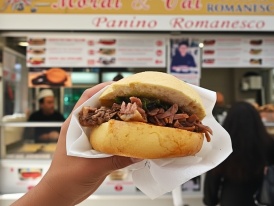
Warm panino at Mordi e Vai in Mercato Testaccio
Sunset from Pincio or Gianicolo
Climb for the wide view when rooftops turn gold and the domes hold light a moment longer. Pincio sits above Piazza del Popolo at the edge of Villa Borghese. Gianicolo rises over Trastevere with a longer sweep of the city. It is the cleanest way to feel Rome exhale before dinner.
Because No Two Travelers Are the Same
We help you shape a city day that matches your pace, your style, and your curiosity, not a fixed route.
Must-See Things to Do in Rome
Morning is for the bones of ancient Rome. Book the first timed slot you can, usually around 9 AM, then let the light do the work.
The Colosseum and Roman Forum: Where Ancient Rome Began
The Colosseum is Rome’s number one tourist attraction and one of the New 7 Wonders of the World, but it was never only entertainment. It was political theater. Emperors staged generosity and control while a crowd of around 50,000 watched beasts, executions, and choreographed battles. I still get a jolt when I look down at the hypogeum and picture the elevators bringing cages up into daylight. From the upper tiers, you see how the Roman Empire planned spectacle as policy. Timed entry is mandatory, and slots usually release about 30 days ahead, so I grab the earliest one and step straight into the Roman Forum while it is still quiet.
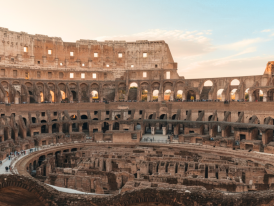
Inside the Colosseum at sunrise, tiers and hypogeum in view
Palatine Hill: Where Rome Began
Palatine Hill often gets rushed, which is a mistake. This is where the legend of Romulus lives, and later emperors chased breezes with terraces and gardens. I bring friends up here for the long views over the Roman Forum and the Circus Maximus. Inside the small museum, the frescoes put daily life back into those rooms. Your ticket for the Colosseum links the Roman Forum and Palatine Hill, so take your time.
Walking the Forum: Follow the Via Sacra
The Roman Forum demands patience. What looks like scattered ruins was once the stage where senatorial debates shifted borders. The stones under your feet heard Cicero, and they felt the aftermath of Caesar’s assassination at the Curia of Pompey in today’s Largo di Torre Argentina. You also walk where triumphs paraded Egyptian gold and Germanic captives through a city that loved spectacle. It was the political heart of the Roman Empire. Follow the Via Sacra and watch how temples, courts, and arches braid politics with religion. With the first Colosseum slot around 9 AM, you can walk straight into the Roman Forum while it’s still cool and quiet, then climb Palatine Hill before midday.
Vatican City: St. Peter’s Basilica and the Vatican Museums
Vatican City is the smallest country in the world, and you feel art, faith, and politics sharing the same streets. Afternoons work well here, when the square softens. St. Peter’s Basilica is free to enter, and everyone goes through security in the piazza. Keeping shoulders and knees covered keeps things smooth inside a working Catholic Church. Michelangelo’s dome rises to about 448 feet, and Bernini’s bronze Baldacchino anchors the altar. If the line is short, go straight in, take your time in the nave, then decide on the dome climb when you see the line and feel the heat.
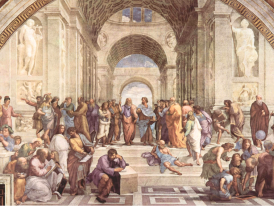
Wide view of School of Athens
The Vatican Museums are a different rhythm. After a few crowded mistakes, I learned to reserve a timed slot and keep a simple route. I move slowly through Raphael’s Rooms, take a breather in the Pinacoteca, then reach the Sistine Chapel when the wave eases. Yes, the Sistine Chapel is on the one-way route. Time your loop so you reach it as the rush thins. On a heavy day, one early-entry morning is worth it for that first calm hour before general admission.
Plan light and keep your ticket on your phone. Hours shift with the season, so I check the plan the night before and adjust. If I am pairing the basilica and the museums on the same day, I do the church early or late and keep the timed museum visit in the middle. It feels human that way, and you avoid the worst of the squeeze.
Fountain Culture: Trevi Fountain and Piazza Navona
From here, head back to the water. Trevi Fountain is Rome’s most famous fountain. The tradition says it brings you back to the Eternal City. Beneath Trevi runs the Aqua Virgo aqueduct (Acqua Vergine), a spring line built in 19 BC that still delivers fresh water into the historic center before it surfaces here. That is why the water runs clear and steady. Access is free, but the city sometimes uses one-way routes and crowd control at peak times. I go after dinner, around 8 PM or 9 PM, when the heat drops and the square feels calm again.
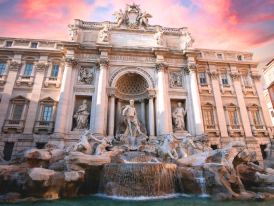
Trevi Fountain at evening
Piazza Navona is Rome performing itself. Bernini’s Fontana dei Quattro Fiumi turns the Church’s reach into four rivers, from the Nile to the Ganges to the Danube and the Rio de la Plata. The oval sits on the footprint of Domitian’s stadium, which is why it feels like a racetrack. Surrounding palazzi show how the Renaissance era reshaped the square and set the tone for its theatrics. Linger to people-watch, then slip down Via dei Coronari toward the Tiber River.
The Spanish Steps: More Than Just Famous Steps
The Spanish Steps (Piazza di Spagna) feel like an outdoor theater. The staircase climbs from the square to the church of Trinità dei Monti, and on the piazza, the Palazzo di Spagna houses the Spanish Embassy to the Holy See. The boat-shaped Fontana della Barcaccia at the base sits slightly below street level to suit the low pressure of the Acqua Vergine, so the water seems to rise from the stone.

The Spanish Steps (Piazza di Spagna) on a bright afternoon
Most evenings, I slip along Via Condotti toward Via del Corso at Largo Goldoni around 6:30 PM, climbing as the shop windows trade workday glare for warm reflections. The steps are for moving, not perching, and the city fines people who sit, so I pause at the top instead. The reward is a quiet, steady view as rooftops take on their last color and St. Peter’s dome holds the light a moment longer. If time allows, I follow the ridge to the Pincio terrace for a wider look, then wander back into Piazza di Spagna after sunset.
Galleria Borghese in the Park (Book Ahead)
Villa Borghese is the green lung of the Eternal City, and its gallery stays intimate because visits run in two hours with a reservation. Arrive a little early, stand close to Bernini until the marble looks like skin, then cross to Caravaggio, where the beautiful interiors make the light feel new. Keep the phone in your pocket and let the room breathe. Afterward, I walk under the pines toward the Pincio terrace for a breathtaking view across the city center. It is a small loop that lives longer than bigger tourist attractions.
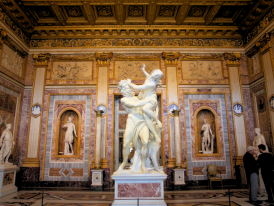
Bernini sculpture at Galleria Borghese
Pantheon: Oculus and Light
Built under Roman Emperor Hadrian, this former Roman temple, now a church, turns daylight into a clock. The oculus is the only opening, so the sun writes the hour across the dome. There is an entrance fee now and long lines at noon, so slip in late afternoon around 5 PM when the square calms. Step inside, look up, and let the geometry explain itself. It is an ancient city, still running inside Italy’s capital city.
Step in, look up, then slide out to a quieter side street for coffee.
Overrated Sights in Rome, and Smarter Alternatives
Some famous sights lose their magic under crowds and phones. Here is how to keep them worthwhile.
Pantheon: Keep (Go Late)
The proportions are perfect, but midday turns the square into a selfie pit, and there is a ticket now, which means two lines. Go late afternoon when the oculus light still moves and the noise drops. Step in, look up, then slide out to a quieter side street for coffee.
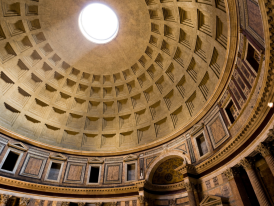
Late afternoon inside the Pantheon under the oculus
Vittorio Emanuele II Monument: Alternative (Pincio Terrace)
We call it the wedding cake. The terrace views are wide, but the building feels like a backdrop, a monument to the first king of a unified Italy. For views with mood, walk to the Pincio terrace near sunset. You get the domes, the Tiber River, and a softer edge to the city.
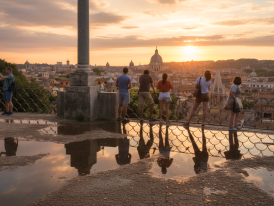
Sunset view from Pincio terrace over Rome’s domes and the Tiber River
Campo de’ Fiori Market: Tweak (Go Early or Treat It as Nightlife)
Midmorning can feel staged and prices creep. Go at dawn on weekdays when vendors set up and tour groups have not arrived, or skip the market and return after dark when the square flips to bars. For real grocery runs, locals use indoor neighborhood markets like Mercato Testaccio.
Not Just Another Place on the List
Experience it through hidden corners and stories most visitors miss.
Hidden Gems That Deliver Authentic Roman Experiences
When the center turns into a backdrop, head for places where Rome breathes again. These are the spots I use to reset the day and remind friends that the Eternal City is more than lines. If you like chasing hidden gems in Rome, these are the places where locals still linger and the city exhales.
Centrale Montemartini: Ancient Art in a 1912 Power Plant
In Ostiense, classical marbles stand among turbines, gauges, and tiled halls. The clash is the point. Venus and Mars feel newly made when a steel gantry frames them. Midmorning light hits just right, wander the old industrial streets for coffee, then cut back toward the river. It is the museum I use when friends need their eyes recalibrated after the center.
Palazzo Altemps: Sculpture in a Quiet Renaissance Palace
A few minutes from Piazza Navona and somehow calm. The Boncompagni Ludovisi collection lives in rooms that feel domestic, so faces and hands come forward instead of labels. Linger with the Ludovisi Throne, listen for footsteps in the loggia, then step out to the courtyard for air. If I want to stay in the mood, I pair it later with the Boxer at Rest at Palazzo Massimo and call that my art day.
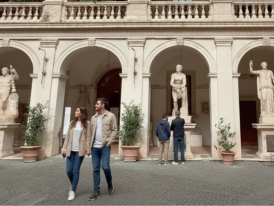
Quiet Renaissance courtyard at Palazzo Altemps
Casina delle Civette: Art Nouveau Glass in Villa Torlonia
Locals call it the House of Owls. Stained glass throws color across wood floors and stairs that look borrowed from a storybook. My mother brought me here on hot afternoons to cool down in the garden and watch the light change. I still bring visitors who think they know Rome’s every angle. Late afternoon is best when the paths are quiet and the glass starts to glow.
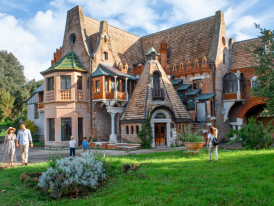
Casina delle Civette exterior, stained glass windows in afternoon light
Quartiere Coppedè: Storybook Architecture in a Tiny District
Around Piazza Mincio, a pocket of early 1900s fantasy survives. Gino Coppedè stitched mosaics, arches, and odd angles into a small stage set where the Villino delle Fate wears painted mottos and tile inlays. The Fountain of the Frogs burbles in the middle, and the traffic forgets itself for a minute. When a pause helps, cut through, look up at the balconies and lanterns, then grab an espresso at whatever corner bar is open. Some days, I keep walking toward Villa Torlonia. Other days, I head back to the center along Via Po when the light starts to turn.
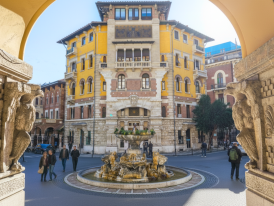
A wide street view showing Gino Coppedè’s ornate facades and arches around Piazza Mincio
Non-Catholic Cemetery of Rome: Poets’ Garden by the Pyramid
By the Pyramid of Cestius and Porta San Paolo, the Non-Catholic Cemetery of Rome (Cimitero Acattolico) feels like a walled garden more than a graveyard. Keats rests here. Shelley too. Slip in after Testaccio, when cats curl on warm steps and late light makes the cypress look painted. Voices fall on their own. I read a few lines, leave a small donation at the gate, and walk out calmer than I came in. Wear quiet shoes and treat it like a church.
Too Many Lists, Not Enough Clarity?
We make exploring simple by connecting you with someone who knows the city and helps you spend your time on what matters to you.
Food That Defines Rome: Dishes and Daily Rituals
Roman cooking is simple and proud. La cucina povera turns a few ingredients into comfort. If you want amazing Italian food and are deciding what to eat in Rome, follow the technique, not the signs, and keep it local. If you are collecting ideas for Rome what to eat, start with the dishes below and let the venues follow.
Carbonara, Amatriciana, and Cacio e Pepe: The Roman Canon
Perilli a Testaccio
Walk in, and it feels unchanged. Tiled floors, wooden chairs, waiters in white jackets moving between carafes of house wine and plates that look like my childhood Sundays. The menu is the Roman canon done straight. No tricks, just timing and heat. I order cacio e pepe when I want to taste starch and pecorino working together. On louder days, I switch to amatriciana. Portions are honest, and the pace is unhurried, so let the room set the rhythm and talk.
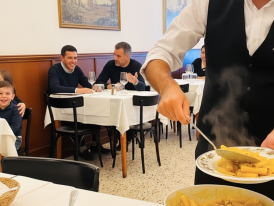
Waiter plating cacio e pepe at Perilli a Testaccio
Trattoria Da Cesare al Casaletto
This is weeknight Rome. Families, paper placemats, and plates that arrive hot. The fritti are light, the fresh pasta lands properly creamed, and when artichokes are in season, add Jewish-style artichokes (carciofi alla giudia), a dish that moved from the Jewish Ghetto into every Roman kitchen I know. Share a half portion of carbonara to start, then decide between amatriciana or cacio e pepe. On weekends, I call ahead because the dining room fills with locals first.
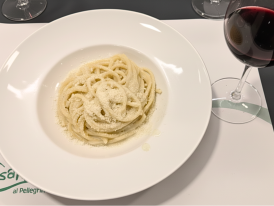
Carbonara at Trattoria Da Cesare in Monteverde
Supplì: The Fried Warm-Up Before Dinner
Necci dal 1924
Necci slides from café to trattoria as the day turns. Meet friends for a spritz and supplì, then decide if it is a dinner night or just a long conversation under the trees. On warm evenings, the terrace pulls you in, and the street becomes background music. It is the kind of place that reminds you that simple can be special.
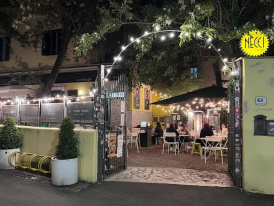
Necci dal 1924’s terrace with string lights and diners
Hungry to Taste Rome Like a Local?
From tucked-away eateries to lively markets, discover flavors worth your time.
Market Panini: Quinto Quarto Between Errands
Mordi e Vai
Inside Mercato Testaccio, a tiny counter turns quinto quarto into warm panini that taste like home cooking on bread. Order tripe or beef heart when it is on, ask for extra sauce, and eat standing by the metal shelf with market noise in your ears. Regulars buy for tonight, not the week, so you learn what to eat in Rome just by watching what goes into their bags. If friends only have time for one quick bite, send them here first.
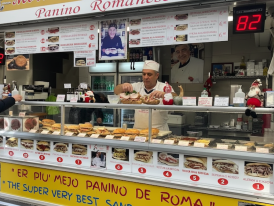
Vendor slicing panini at Mordi e Vai in Mercato Testaccio
Mercato Testaccio
This market is the routine behind the plates. You buy for today, not the week. Vendors point to what is sweetest and in season and tell you how to cook it. Come early for bread and vegetables, grab a quick coffee at the bar, and watch people plan lunch on the fly. It is real life, not a show, and it teaches you what to eat in Rome better than any food tour.
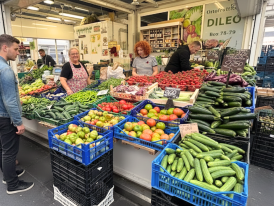
Morning produce stalls at Mercato Testaccio
Pizza Al Taglio: Street Fuel Between Sights
Roman pizza by the slice keeps you moving through the city center. The base is thin and crisp, so it holds its shape while you walk. Keep it simple with pizza bianca or ask for pizza con mortadella, pay by weight, fold, and keep going. Order two small pieces instead of one large if you want to taste more.
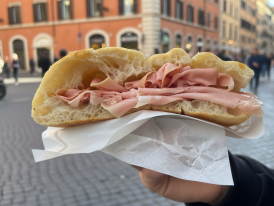
Someone holding a slice of pizza bianca with mortadella on a Roman street
Jewish-Style Artichokes: Where To Find the Crunch
When artichokes are in season, this dish from the Jewish Ghetto shows up everywhere. Crisp leaves, tender heart, a squeeze of lemon. Order them in the Jewish Ghetto around Via del Portico d’Ottavia, and you will taste why the style traveled into every Roman kitchen.
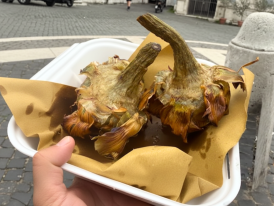
Golden fried carciofi alla giudia in Rome’s Jewish Ghetto
Beyond a Experience
One-to-one hosting, flexible starts, small detours that become stories. Rome fits you, not the other way around.Signature Leisure and Culture: Evenings That Feel Roman
When the heat drops, the city comes outside. This is Rome at night in its natural rhythm.
The Evening Passeggiata
The passeggiata is a slow walk that turns streets into an open living room. I loop two or three piazzas, let the kids run the edge of a fountain, and talk to friends I have not seen since morning. Some nights it is a quick circuit near home. Other nights, I cross a bridge to watch the Tiber catch the last light. You do not need a route. You need unhurried feet.
Aperitivo Hour
From about 6 PM to 9 PM, the city loosens its tie. Aperitivo is a drink with small bites and a reason to sit together before dinner. Order a Negroni or an Americano and ask for whatever olives and crisps they are serving. Good bars keep it simple, and the point is conversation, not stacking plates. If you want a by-the-glass list near Campo de’ Fiori, Il Goccetto keeps small producers on the chalkboard, so go early to grab a spot.
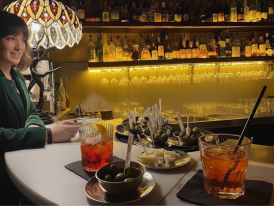
Negroni and olives at a Roman wine bar near Campo de’ Fiori
Coffee After Dinner
Coffee culture keeps going after dark, but the rules do not change. Espresso at the counter. Quick. No cappuccino after 11 AM. My own loop still passes Enoteca Bulzoni in Parioli, a 1929 wine shop with a small kitchen where my grandfather taught me to taste. He ordered the same Frascati from the Castelli Romani every time. I stop in for a small glass or a coffee, nod to the owner, and head out into the quiet streets.
Plan Smarter, Travel Better
Chat with someone who lives there and avoid wasting time on tourist traps.
Rome by Interest: Themes That Fit Your Day
Pick a theme, not a checklist. These pivots drop into any schedule and keep the day moving at a human pace. With a spare day, fold in Rome day trips like Ostia Antica for sea air or the Castelli Romani for cool hills and wine.
Art That Rewards Patience: Rooms Worth Lingering In
Pick a few rooms and slow down. A two-hour reservation at the Galleria Borghese lets Bernini and Caravaggio breathe, and quiet mornings at the Capitoline make faces read like people, not labels. Step back outside to the terrace, and the Forum lines up the story under your feet.
History Deep Dives: Walk the City’s Spine
Follow the Via Sacra through the Forum while it is still cool, then climb Palatine Hill for the long look over the Circus Maximus. If the Palatine museum is quiet, give the frescoes ten minutes, then return to the terraces for air and context.
Design and Photography: Shapes, Light, and Texture
Blue hour at Trevi and Piazza Navona is gentler on the lens. The oval of Navona sits on Domitian’s stadium, which is why it photographs like a racetrack. Drift down Via dei Coronari for stone doorways and old glass, or swing past Quartiere Coppedè when you want storybook details without a crowd.
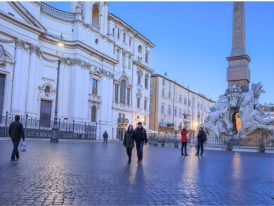
Blue hour at Piazza Navona with Bernini’s Fontana dei Quattro Fiumi
Family and Easy Days: Green Space Without Drama
Villa Borghese is the reset button. Walk the shade paths, let the kids wander near the edge of the lawns, and angle toward the Pincio terrace for the citywide view. On warm days, I keep it simple with water, a bench, and an unhurried loop back toward Piazza del Popolo.
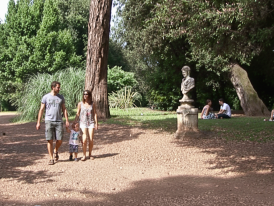
Villa Borghese shade paths, families and friends
Nature and Views: Rivers, Ridges, and Dusk
Cross a bridge at sunset and watch the Tiber pick up color. Pincio gives you domes and soft light. Gianicolo stretches the skyline farther and stays breezy. End the day with a slow walk downhill and a last look at the river before dinner.
Beyond the Checklist
Discover the city guidebooks don’t cover with a local by your side.
Rome Neighborhoods: Where the City Really Lives
Balance the famous sights with time in real streets. Lanes, markets, and small piazzas explain the city faster than any list of top attractions. Think of this as a local map to Rome neighborhoods that still feel lived-in.
Trastevere: Lanes, Piazzas, and Evenings by the Tiber River
Across the Tiber River, the cobbles set your pace. Slip in from Ponte Sisto, pass Santa Maria in Trastevere, and let the mosaic catch the last light. People-watch in a small piazza before dinner and take the long way through back lanes. Trastevere still feels like a village in the city center when the heat drops.
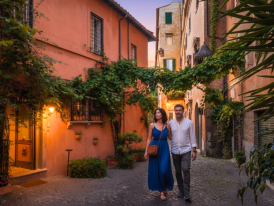
Trastevere at dusk, cobbled lanes near Santa Maria
Testaccio: Working-Class Food Culture and Quinto Quarto Roots
Testaccio explains how Romans eat. Come for an honest plate and a glass of house wine, then wander past Monte Testaccio, where ancient pots were once stacked up like a hill. Old trattorias keep quinto quarto traditions alive, and newer kitchens keep flavors clean. On match nights, you feel the capital city’s mood in every bar.
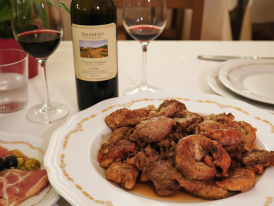
House wine and quinto quarto in a Testaccio trattoria
Centro Storico: Ancient and Baroque at Walking Speed
The centro storico stacks historic sites in tight blocks. I follow Via del Governo Vecchio toward Piazza Navona for Bernini’s Fontana dei Quattro Fiumi, then drift a few turns into a market square that wakes early and flips to bars by night. When I need a straight line, I use Via del Corso, the main shopping spine from Piazza del Popolo to Piazza Venezia, then cut over to Piazza di Spagna if I want the Spanish Steps. Thanks to its central location, treat it as one long walk that links eras without effort.
Monti: Boutiques, Studios, and a Pocket Piazza
Between the Colosseum and the Roman Forum, Monti reads like a small town. Browse Via del Boschetto and Via Panisperna, then pause in Piazza Madonna dei Monti with a quick coffee. It is the gentlest reset after the big historic sites.
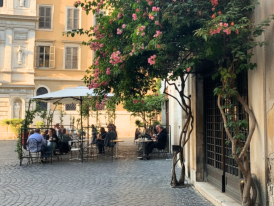
Piazza Madonna dei Monti with locals and a corner café
Prati: Calm Streets Near Vatican City
For a Vatican day, based in Prati. Wide sidewalks, daytime errands, and a fast lunch before or after St. Peter’s Basilica or the Vatican Museums. Walk the river back toward the center when the bridges turn gold.
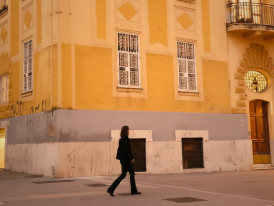
Calm Prati street near the Vatican at golden hour
Pigneto: Creative Evenings East of the Center
Tree-lined streets, small bars, and simple plates. Meet friends for a spritz, decide if it is a pizza night, then keep the walk going. It is an easy way to see an Italian city after work without a hassle.
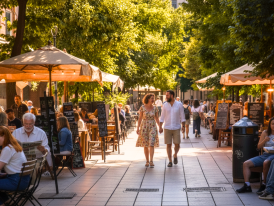
Evening spritz on a tree-lined street in Pigneto
Practical Tips for Rome: Transport, Tickets, Etiquette
Plan light, keep documents on your phone, drink water, and move with the shade.
Getting Around Without Stress
- Tap & Go: Use a contactless bank card on metro gates and buses across the city center.
- Weekly Pass (CIS): Good value if you ride often. Valid to midnight on day seven.
- Plan One Long Walk: Link top attractions on foot instead of stacking short rides.
- Taxis: Use official taxi stands at night rather than hailing on the street.
- Footwear: Cobblestones and uneven paving are common in the capital city. Wear supportive shoes you trust.
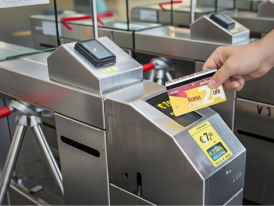
Tapping a contactless card at a Rome metro gate
Accessibility and Booking Realities
- Step-Free Access: Look for elevators and alternative entries at the Colosseum and major museums. Big churches often have ramps or side doors. Main piazzas and the riverfront are stroller-friendly.
- Timed Releases: Most timed entries open roughly 30 days in advance. Popular slots go quickly.
- Dome Climbs: The elevator option costs more than stairs and can have its own line.
- Peak Days: Free Sundays and holiday periods bring heavy lines. Start early or shift to late afternoon.
Churches and Major Museums: What to Know
- Dress Etiquette: Cover shoulders and knees in any working Catholic church, including St. Peter’s Basilica. A light scarf solves this fast.
- St. Peter’s Basilica Entry: Free for all visitors. Everyone passes security in the square.
- Vatican Museums Tickets: Book timed entry. Early entry or late afternoon reduces long lines.
- Colosseum, Roman Forum, Palatine Hill: Timed slots required. The first entry around 9 AM is the calmest.
- Pantheon Entrance Fee: Ticket required. Midday draws long lines, so plan late afternoon.
- Free Museum Sunday: Many state museums are free on the first Sunday of each month. Expect crowds and arrive early.
- Roma Pass: Covers transport and includes one site for 48 hours or two for 72 hours. Reservations still apply where required.
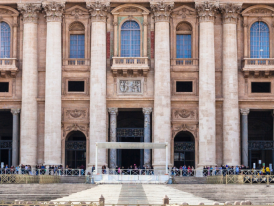
Light scarf at St Peter’s security line
Money, Water, and Small Habits
- Cards and Cash: Cards work widely, but carry small cash for bars, gelato, and markets.
- Water: Refill a bottle at the nasoni fountains across the city center.
- Coffee Rules: Espresso at the counter is the norm. No cappuccino after 11 AM.
- Heat Strategy: Do big interiors at midday. Save piazzas and long walks for the evening.
- First-Visit Mindset: Keep plans light when you visit Rome. Leave space to adjust.
More than 25,944 5-star reviews and counting
25,944+ 5-Star Reviews and Counting
Trusted and recommended by travelers worldwide.
Frequently Asked Questions: Things to Do in Rome
1) What Are the Best Things to Do in Rome for a First Visit?
Start with the Colosseum and Roman Forum in the morning, visit Vatican City or St. Peter’s Basilica in the afternoon, then walk the centro storico for fountains and piazzas in the evening.
2) Do I Need to Book the Colosseum Ahead of Time?
Yes. Timed entry is mandatory and usually opens about 30 days in advance. I book the first slot around 9 AM and roll straight into the Roman Forum and Palatine Hill while it is cool.
3) Where Can I Try Classic Roman Pasta That Locals Love?
Perilli a Testaccio and Trattoria Da Cesare al Casaletto keep the canon tight. Order cacio e pepe or amatriciana and let the room set the pace.
4) How Do I Get From Fiumicino Airport to Central Rome Quickly?
Take the Leonardo Express. It runs nonstop to Termini in about 32 minutes.
5) Is Fountain Water Safe To Drink in Rome?
Yes. Fill your bottle at the nasoni fountains.
6) When Is Museum Entry Free in Rome?
Many state museums are free on the first Sunday of each month. Expect crowds and check details in advance.
7) Do I Need To Cover My Shoulders and Knees in Churches?
Yes. Dress modestly for St. Peter’s Basilica and other Catholic church sites. A light scarf solves it fast.
8) Is Pizza by the Slice a Local Thing?
Yes. Pizza al taglio is classic street fuel. Pay by weight, fold, and keep walking.
9) Are Taxis Easy To Get Late at Night?
Use official taxi stands or call a radio taxi. Do not hail on the street.
10) Is Rome Walkable for Most Sights?
Yes. Many top attractions sit within the compact city center. Wear shoes you trust.
11) How Do I Avoid the Biggest Crowds at Tourist Attractions?
Book early time slots, visit late in the day, or aim for weeknights. Keep big interiors for midday heat.
12) What Should I Wear for Cobblestones and Summer Heat?
Supportive shoes and light clothing. Bring a hat and refill water often.
13) Where Can I Throw a Coin for Good Luck?
The Trevi Fountain is a famous spot. Stand with your back to the water and toss one coin with your right hand over your left shoulder. The tradition says it brings you back to the Eternal City.
14) Do I Need a Guided Tour of the Colosseum and Forum?
Not required. A good guide adds context and may include special areas like the Arena Floor or Underground. You still need a timed entry.
15) What Are the Best Tours for Early Vatican Entry?
Look for early entry or after-hours options so you reach the Sistine Chapel before the main wave. Keep your route simple and booked in advance.
Final Notes on Rome: Let the City Lead
Rome works when you let the headline sights and small habits meet. I start with one famous place, drink an espresso at the counter, then give the day back to street life. A quiet church when the heat peaks. A long walk through the city center. A piazza at dusk when the stone finally cools. That rhythm is the Eternal City at its best.
The Italian capital city rewards attention, not speed. See the iconic places, then leave space for a market errand, a side street, a glass of wine where no one needs a microphone. You feel ancient Rome under your feet and a living metropolis around you. That is the point here. It is not a checklist. It is how you use the city.
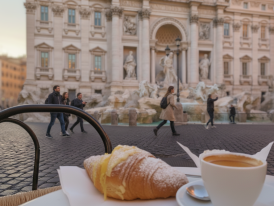
Morning espresso in a Roman café and visitors enjouing and rushing past the Trevi Fountain
Let curiosity run the day. Start with one top sight, then follow the noise of a market, take a turn you did not plan, and keep walking when the music changes across the Tiber River. If you are exploring beyond Rome, Italy experiences will help you keep the same pace from city to coast.
There’s More to Explore in Italy
Ready to Plan Your Perfect Day in Rome?
Start your experienceWhat If Your Day in Rome Was Planned by Someone Who Knows It — and You?
City Unscripted matches you with a local host who creates a private experience based on your interests, not a set route.
Want to Experience the Real Rome With Someone Who Lives There?
A fully private experience, planned and led by a local host who tailors the day to you
